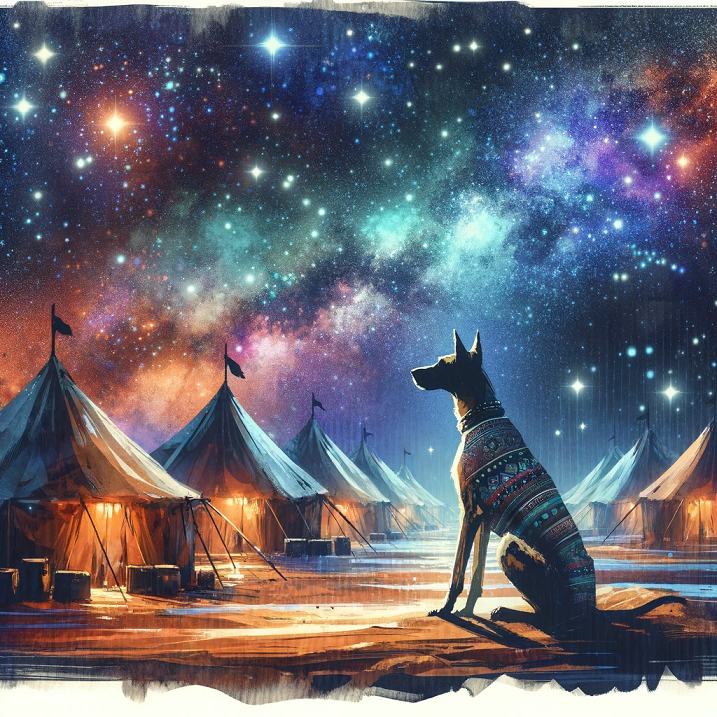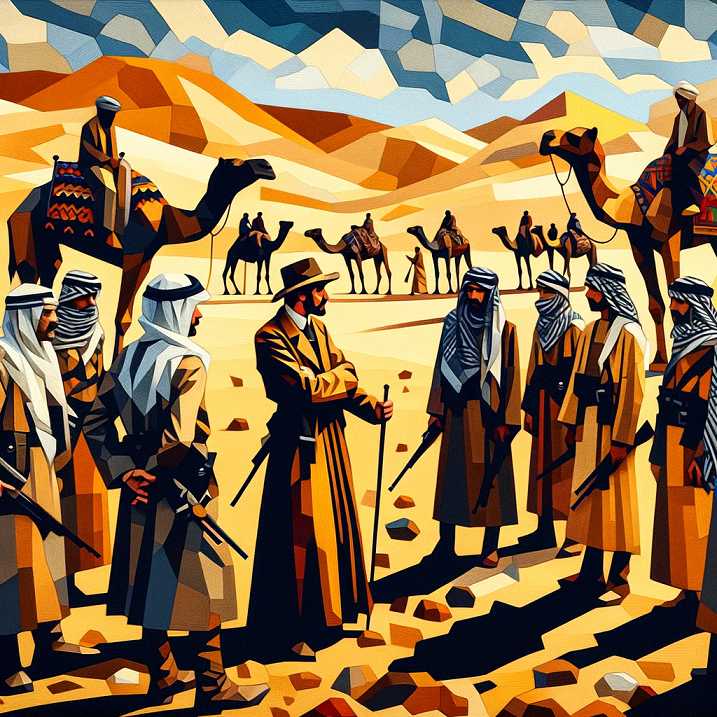In the study of Middle Eastern ethnography, few works offer as vivid a portrayal of the Bedouin Arabs as H.R.P. Dickson’s seminal “The Arab Of The Desert.” A detailed account of life, customs, and struggles, Dickson’s narrative brings to life the early 20th-century Kuwait with acute observation and engaging storytelling. Here we focus on one of Dickson’s most compelling accounts, his journey to Wafra, a venture laden with cultural encounters and natural challenges, culminating in a significant meeting with Ibn Saud’s patrol. The journey is both a physical traverse through arid lands and a deep exploration of the interactions, politics, and societal norms of the time.
Key Takeaways
- The journey to Wafra encapsulates the rugged beauty and inherent challenges of the Arabian desert.
- Dickson’s interactions with local families reflect the deep-rooted hospitality and communal support among Bedouins.
- Night disturbances by wolves underscore the perpetual battle between man and nature in the desert.
- The use of a hawk in hunting illustrates the intricate relationship between the Bedouins and their environment.
- The meeting with Bin Saud’s patrol reveals the complex political landscape of early 20th-century Arabia.
- Dickson’s resilience and reflective nature highlight the depth of his ethnographic commitment and understanding.
- The return journey to Araifjan serves as a period of reflection and assimilation of the expedition’s experiences.
Preparations for Departure
As dawn broke over the Kuwaiti landscape, Dickson found himself embarking on a journey to Wafra, situated on Kuwait’s southern border with KSA, an endeavour that required meticulous preparation and foresight. The early hours were met with a flurry of activity, central to which was the culinary expertise of Amsha, the wife of Dickson’s aide Salim, who prepared a hearty meal to sustain them for the day ahead. This meal, comprising three chickens and a bowl of rice, was not only a testament to the culinary skill of his hosts but also a crucial sustenance for the demanding journey ahead.
Equally important were the preparations of essential items. Dickson ensured that all necessary gear was accounted for – lunch, water, coats, rifles, and a generous supply of ammunition. These items were lifelines in the unforgiving desert terrain, tools for protection, sustenance, and navigation. The packing of these items was a ritual in readiness, each piece a reminder of the challenges and uncertainties that lay ahead.
I prepared to leave for Wafra with Sa’ud, my hunter. Once more the little camp is astir and busy. My car is got ready, my lunch, cooked to a turn, is brought out of the women’s tent, and tightly packed away in the tin saucepan and firmly covered. For water we depend on the filled leather goatskin tied on the near running-board. We are off, Saleh, my driver, Sa’ud and myself, the first two in front of the car and I behind with coats, lunch, rifles, bandoliers, shot-guns and bags of cartridges.
Lt Col Dickson The Arab Of The Desert
Disturbances in the Night
As night descended upon the encampment, a sense of unease took hold, marked by the fierce barking of the newly introduced watch-dog. This disturbance, initially an unsettling background noise, soon escalated into a harbinger of loss. Dickson, though wearied by the day’s preparations, was roused to the grim reality of desert life – the predation by wolves. Despite the vigilance of the shepherds and the protective presence of the dogs, two sheep were cleverly and silently taken by the wolves, a stark reminder of the perpetual battle between man and nature in these parts.
The loss of the sheep was more than a mere economic blow; it was a poignant moment that cast a shadow over the camp. The efficiency and silence of the attack spoke volumes about the cunning of the desert predators and the vulnerability of those living at its mercy. It was a moment that undoubtedly left an indelible mark on Dickson, underscoring the fragility of life and livelihood in the harsh desert environment.
“Ya Salim, there are two short. Come quick, a ewe and a lamb are missing.” A hurrying of feet, then eager talking. A further cry, “A wolf, it is a wolf”. “A wolf has done this in the night.” From right under their noses, a he- and she-wolf had clearly visited the camp and carried off the animals in the dark. A quick cast round and the enemies’ pug-marks were found.
The he-wolf had cleverly given the watch-dogs his scent on the side from which the wind was blowing, and as soon as the clogs had rushed after him into the night his cunning spouse had crawled close up to the tents on the other side, much as a cat crouches and creeps after a mouse (except that the wolf seems to drag its belly along the ground in doing so, if its tracks in the sand indicate anything) and had dragged away in silence two sheep, one full-grown and one a lamb.
Lt Col Dickson The Arab Of The Desert

This incident, while brief in the grand tapestry of his journey, encapsulated the constant vigilance required to navigate the challenges of the Arabian desert. It was a sobering reminder of the balance between life and death, a balance ever so delicate in the vast, unforgiving sands. As Dickson pondered over the loss, the night’s disturbances laid bare the realities of the Bedouin existence, where every day was a testament to resilience, courage, and the relentless struggle for survival.
The Journey to Wafra
As the sun crested the horizon, Dickson embarked on his journey to Wafra, a path fraught with natural challenges and underscored by a rugged determination. The terrain was as daunting as it was beautiful, with the ‘arfaj bushes presenting a relentless obstacle course that tested the endurance of both man and machine. Despite the advice of his guide, Sa’ud, Dickson chose an unfamiliar route, a decision that epitomised the spirit of exploration and adventure that defined his journey.
Along the way, the Arabian desert revealed its dual nature – both as a barren expanse and a vibrant ecosystem. The encounter with a bustard, a moment that blended the thrill of the hunt with a deep appreciation for the natural world, was a testament to the latter. The use of the hawk, a traditional hunting companion, highlighted the intricate relationship between the Bedouin people and their environment, a synergy of survival and respect.
Meeting with Ibn Saud’s Patrol
Upon reaching Wafra, Dickson’s journey took a significant turn as he encountered Ibn Shaja’an leading Bin Saud’s patrol. This meeting was not merely a chance encounter but a moment laden with geopolitical implications. Ibn Shaja’an, described as “dour” and “somewhat fanatical”, represented the broader political tensions and power struggles that pervaded the Arabian peninsula at a time when fixed national boundaries were yet to be established. The patrol’s official purpose of meeting with Captain Papworth, an RAF officer, for mapping and surveying belied a more pressing mission — hunting down ‘Awazim tribesmen who had evaded the King’s call to arms.
We reached Wafra at 12.30 p.m. and found Bin Sa’ud’s patrol under the dour and rather fanatical Ibn Shaja’an, an unpleasant man of the type so often found on the Sa’udian frontier. Plenty of wind in the head, scarcely civil and, according to report, notoriously cruel. He had come up from Hufuf, he said, by Bin Jiluwi’s orders, to get in touch with Captain Papworth, the R.A.F. Survey Officer who was to revise the map of Kuwait and survey the Neutral Zone.
This was a pretext. His obvious reason was to hunt down certain poor Awazim tribesmen who had evaded the King’s call to arms for his coming Yaman campaign. I made Ibn Shaja’an give me a cup of coffee and some nasty tea, and told the man that the Survey Officer would not require his services seeing that he had both guard and guides from the Shaikh of Kuwait. Ibn Shaja’an did not appear over-pleased. I left him with relief, after examining and giving quinine to one of his men lying in a corner groaning with fever.
Lt Col Dickson The Arab Of The Desert
Dickson’s interaction with Ibn Shaja’an was marked by a blend of diplomatic necessity and underlying tension. Despite the harshness and reputed cruelty of the patrol leader, Dickson navigated the conversation with the acumen of an experienced traveller and observer of human nature. The exchange over coffee and the refusal of Ibn Shaja’an’s services highlighted the significant yet subtle negotiations that often underpin such encounters.

Return and Reflections
With the meeting at Wafra behind him, Dickson commenced his return journey to Araifjan, a route that retraced the physical and emotional contours of his expedition. The return gave rise to a period of reflection and assimilation of the day’s events and interactions. The journey back was marked by a profound physical exhaustion — a tangible reminder of the day’s rigours and the relentless challenge posed by the Arabian terrain. Yet, alongside the weariness was a sense of fulfilment, a testament to the human spirit’s capacity to endure and find satisfaction in the face of hardship.
I returned to Araifjan after another four hours of bumping and straining of my spine and brain. I reached camp at 6.30 p.m., a dog-tired but happy man. I had thoroughly enjoyed my ten hours’ car ride. I had done 255 miles over the most glorious “down” country, with a fine and cool day to help me, only the bumpy nature of the track had somewhat marred what might have been a perfect day.
Lt Col Dickson The Arab Of The Desert
Upon reaching camp, the journey’s conclusion offered Dickson not only physical respite but also a moment to ponder the broader implications of his travels. The experiences gathered were personal anecdotes and valuable insights into the social and geopolitical landscape of early 20th-century Arabia. In this reflective state, Dickson’s journey transcended the immediate and personal, offering a microcosmic view of the larger historical, cultural, and environmental narratives that he was so keenly attuned to document. This return journey and the reflections it spurred were integral to Dickson’s ongoing quest to understand and articulate the complex world of the Bedouin Arabs, their land, and their times.
FAQs
Q: What was the main purpose of Dickson’s journey to Wafra?
A: To explore and document the Bedouin lifestyle and the natural environment of the Arabian desert.
Q: Who prepared the hearty meal for Dickson’s journey?
A: Amsha, showcasing the local hospitality and culinary skills.
Q: What significant wildlife encounter did Dickson have during his journey?
A: He encountered and hunted a bustard using a hawk.
Q: What was the reason for the tension in Dickson’s meeting with Ibn Saud’s patrol?
A: The political undertones and Ibn Shaja’an’s reputation as a dour and fanatical leader.
Q: What does the encounter with wolves signify in the narrative?
A: It underscores the constant vigilance and struggle for survival in the desert.
Q: How does Dickson reflect on his journey upon returning to Araifjan?
A: He reflects on the physical toll and the broader implications of his experiences.

